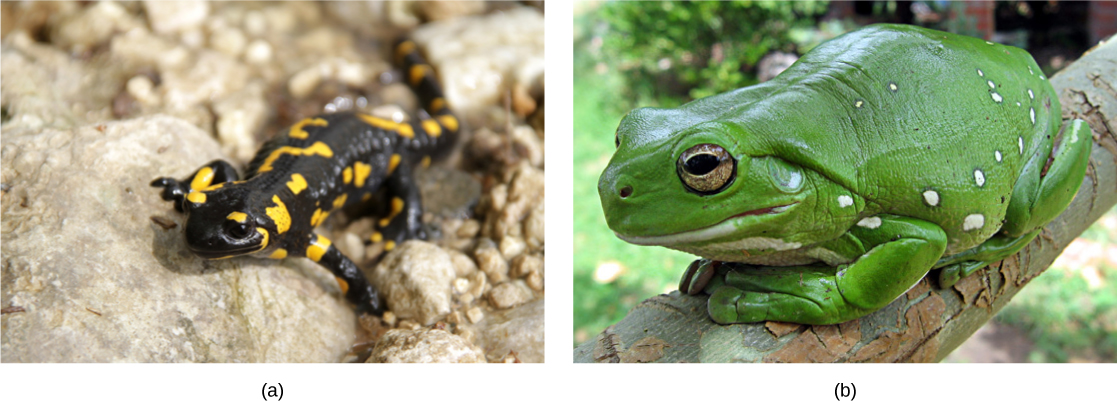| << Chapter < Page | Chapter >> Page > |
Amphibians are vertebrate tetrapods. Amphibia includes frogs, salamanders, and caecilians. The term amphibian means “dual life,” which is a reference to the metamorphosis that many frogs undergo from a tadpole to an adult and the mixture of aquatic and terrestrial environments in their life cycle. Amphibians evolved in the Devonian period and were the earliest terrestrial tetrapods.
As tetrapods, most amphibians are characterized by four well-developed limbs, although some species of salamanders and all caecilians possess only vestigial limbs. An important characteristic of extant amphibians is a moist, permeable skin, achieved by mucus glands. The moist skin allows oxygen and carbon dioxide exchange with the environment, a process called cutaneous respiration . All living adult amphibian species are carnivorous, and some terrestrial amphibians have a sticky tongue that is used to capture prey.
Amphibia comprise an estimated 6,500 extant species that inhabit tropical and temperate regions around the world. Amphibians can be divided into three clades: Urodela (“tailed-ones”), the salamanders and newts; Anura (“tail-less ones”), the frogs and toads; and Apoda (“legless ones”), the caecilians.
Living salamanders ( [link] a ) include approximately 500 species, some of which are aquatic, others terrestrial, and some that live on land only as adults. Adult salamanders usually have a generalized tetrapod body plan with four limbs and a tail. Some salamanders are lungless, and respiration occurs through the skin or external gills. Some terrestrial salamanders have primitive lungs; a few species have both gills and lungs.

Watch this video about an unusually large salamander species.
Frogs ( [link] b ) are the most diverse group of amphibians, with approximately 5,000 species that live on all continents except Antarctica. Frogs have a body plan that is more specialized than the salamander body plan for movement on land. Adult frogs use their hind limbs to jump many times their body length on land. Frogs have a number of modifications that allow them to avoid predators, including skin that acts as camouflage and defensive chemicals that are poisonous to predators secreted from glands in the skin.
Frog eggs are fertilized externally, as they are laid in moist environments. Frogs demonstrate a range of parental behaviors, with some species exhibiting little care, to species that carry eggs and tadpoles on their hind legs or backs. The life cycle consists of two stages: the larval stage followed by metamorphosis to an adult stage. The larval stage of a frog, the tadpole , is often a filter-feeding herbivore. Tadpoles usually have gills, a lateral line system, long-finned tails, but no limbs. At the end of the tadpole stage, frogs undergo a gradual metamorphosis into the adult form. During this stage, the gills and lateral line system disappear, and four limbs develop. The jaws become larger and are suited for carnivorous feeding, and the digestive system transforms into the typical short gut of a predator. An eardrum and air-breathing lungs also develop. These changes during metamorphosis allow the larvae to move onto land in the adult stage ( [link] ).

Notification Switch
Would you like to follow the 'Concepts of biology' conversation and receive update notifications?